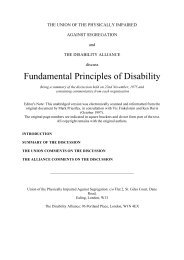Global-Report-Living-Colour-dr2-2
Global-Report-Living-Colour-dr2-2
Global-Report-Living-Colour-dr2-2
Create successful ePaper yourself
Turn your PDF publications into a flip-book with our unique Google optimized e-Paper software.
114<br />
Inclusive Communities = Stronger Communities<br />
GLOBAL REPORT ON ARTICLE 19: THE RIGHT TO LIVE AND BE INCLUDED IN THE COMMUNITY<br />
families, government and community organizations. Alliances should be nurtured with family support<br />
organizations, local advocacy groups, social justice advocates, service groups, unions, business leaders and other<br />
possible allies.<br />
• Establish a clear plan and time frame for closing the institution<br />
o<br />
Government and community leaders must share a clear, unequivocal, public commitment that the institution will<br />
be closed, that resources will be allocated to the community and that planning will ensure that each person<br />
residing in the institution will be supported to move to his or her own home in the community.<br />
• Communicate the announcement clearly and effectively<br />
o<br />
Careful consideration must be given to how the closure decision is announced and how messages will be<br />
conveyed. Undoubtedly there be will at least some opposition to the closure, from various sources, and<br />
government and community leaders must be prepared with clear information about what is planned and why.<br />
• Carefully coordinate/support each person’s transition to the community<br />
o<br />
Many individuals make quick transitions to living in their new home with little to no negative impact. Others may<br />
require a more gradual change from the old environment to the new one. The people who know the person well<br />
will be in the best position to help plan the transition and any intermediate steps, if needed.<br />
Also in the consultation our member in New Zealand said it was also important that:<br />
• Where individuals do not have families involved, independent advocates should be appointed<br />
• People with disability who are moving from institutions and their families being able to visit good<br />
examples of community living so they can see how it works and undertake an evaluation<br />
While the real life stories of people who have left<br />
institutions, testimonials from families, and<br />
overwhelming research point to the world wide success<br />
of institutional closures, the process has not been<br />
without its share of mistakes. The way in which<br />
deinstitutionalization has taken place in many<br />
jurisdictions has left us with a legacy of institutional<br />
thinking which continues to characterize the way people<br />
receive supports and the way service systems are<br />
organized.



